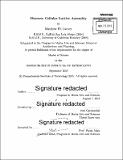Discrete cellular lattice assembly
Author(s)
Carney, Matthew Eli
DownloadFull printable version (21.58Mb)
Other Contributors
Massachusetts Institute of Technology. Department of Architecture. Program in Media Arts and Sciences.
Advisor
Neil Gershenfeld.
Terms of use
Metadata
Show full item recordAbstract
Robotic assembly of discrete cellular lattices at super-hertz (>1Hz) assembly rates is shown to be possible by integrating the design of a modular robotic assembler with the specified lattice topology such that the lattice can itself be removed from the incremental assembly process. Limits to assembly rates are ultimately dependent on allowable error, system stiffness, and damping characteristics. Vibrations due to cyclical motions of the end-effector, locomotion system, and the dynamic response of an incrementally varying lattice must settle to acceptable ranges to enable engagement between end-effectors, discrete elements, and their affixing features to adjacent cells. For given system dynamics, longer settling times enables greater energy dissipation, and less error. With a greater allowable error at the interface, a shorter assembly cycle period can be attained. Passive alignment features designed into the robot end-effectors, locomotion systems, and the discrete lattice elements reduce the precision requirements of the assembly process by opening up the acceptable error range, thereby, enabling higher assembly cycle-rates. An experiment was performed to evaluate how an assembler locally referencing a lattice performed in comparison to a globally referenced assembler. The two assemblers were of similar kinematic form: both gantry-type CNC machines: a ShopBot and a custom built relative robotic assembler. The results showed superior performance by the global coordinate frame system. An error budget analysis of the two systems showed that the locally referenced, lattice based system had a larger more variable structural loop than the global coordinate frame ShopBot. The control experiment, demonstrated 0.1Hz assembly rates, while first order approximations predict a maximum 4Hz cycle for the specified interface geometry. Results show that in order to successfully assemble discrete cellular lattices at super-hertz rates the robot must itself become the local, instantaneous global coordinate frame such that the structural loop is absolutely minimized, while stiffness is maximized; at the instantaneous moment of assembly the structural loop of the robot must reference only itself.
Description
Thesis: S.M., Massachusetts Institute of Technology, School of Architecture and Planning, Program in Media Arts and Sciences, 2015. Cataloged from PDF version of thesis. Includes bibliographical references (pages 109-113).
Date issued
2015Department
Program in Media Arts and Sciences (Massachusetts Institute of Technology)Publisher
Massachusetts Institute of Technology
Keywords
Architecture. Program in Media Arts and Sciences.